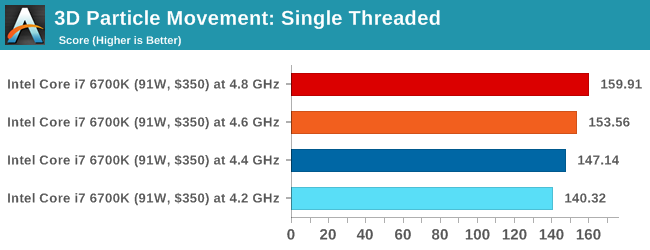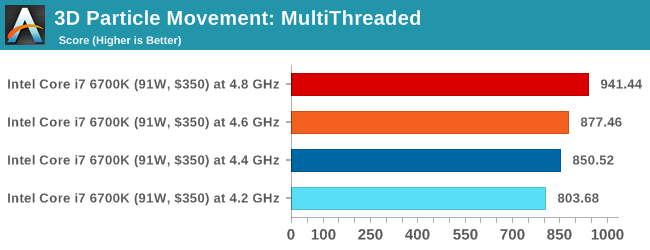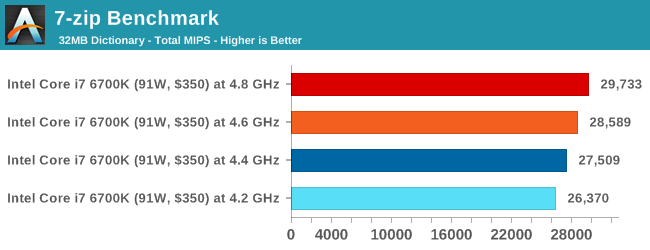The Intel Skylake i7-6700K Overclocking Performance Mini-Test to 4.8 GHz
by Ian Cutress on August 28, 2015 2:30 PM ESTCPU Tests on Windows: Office
WinRAR 5.0.1: link
Our WinRAR test from 2013 is updated to the latest version of WinRAR at the start of 2014. We compress a set of 2867 files across 320 folders totaling 1.52 GB in size – 95% of these files are small typical website files, and the rest (90% of the size) are small 30 second 720p videos.

3D Particle Movement
3DPM is a self-penned benchmark, taking basic 3D movement algorithms used in Brownian Motion simulations and testing them for speed. High floating point performance, MHz and IPC wins in the single thread version, whereas the multithread version has to handle the threads and loves more cores.


FastStone Image Viewer 4.9
FastStone is the program I use to perform quick or bulk actions on images, such as resizing, adjusting for color and cropping. In our test we take a series of 170 images in various sizes and formats and convert them all into 640x480 .gif files, maintaining the aspect ratio. FastStone does not use multithreading for this test, and results are given in seconds.

Synthetic – 7-Zip 9.2: link
As an open source compression tool, 7-Zip is a popular tool for making sets of files easier to handle and transfer. The software offers up its own benchmark, to which we report the result.

Conclusions on Office Benchmarks
Similar to the professional tests, the gains here are in-line with what we would expect with +200 MHz overclocks.










103 Comments
View All Comments
Oxford Guy - Tuesday, September 1, 2015 - link
(says the guy with a name like Communism)HollyDOL - Sunday, August 30, 2015 - link
Well, you might have a point with something here. Even though eye itself can take information very fast and optical nerve itself can transmit them very fast, the electro-chemical bridge (Na-K bridge) between them needs "very long" time before it stabilises chemical levels to be able to transmit another impulse between two nerves. Afaic it takes about 100ms to get the levels back (though I currently have no literature to back that value up) so the next impulse can be transmitted. I suspect there are multitudes of lanes so they are being cycled to get better "frame rate" and other goodies that make it up (tunnel effect for example - narrow field of vision to get more frames with same bandwidth?)...Actually I would like to see a science based article on that topic that would make things straight on this play field. Maybe AT could make an article (together with some opthalmologist/neurologist) to clear that up?
Communism - Monday, August 31, 2015 - link
All latencies between the input and the output directly to the brain add up.Any deviation on top of that is an error rate that is added on top of that.
Your argument might as well be "Light between the monitor and your retina is very fast traveling, so why would it matter?"
One must take everything into consideration when talking about latency and temporal error.
qasdfdsaq - Wednesday, September 2, 2015 - link
Not to mention, even the best monitors have more than 2ms variance in response time depending on what colours they're showing.Nfarce - Sunday, August 30, 2015 - link
As one who has been building gaming rigs and overclocking since the Celeron 300->450MHz days of the late 1990s, I'd +1 that. Over the past 15+ years, every new build I did with a new chipset (about every 2-3 years) has shown a diminished return in overclock performance for gaming. And my resolutions have increased over that period as well, further putting more demand on the GPU than CPU (going from 1280x1024 in 1998 to 1600x1200 in 2001 to 1920x1080 in 2007 to 2560x1440p in 2013). So here I am today with an i5 4690K which has successfully been gamed on at 4.7GHz, yet I'm only running it at stock speed because there is ZERO improvement on frames in my benchmarked games (Witcher III, BF4, Crysis 3, Alien Isolation, Project Cars, DiRT Rally). It's just a waste of power and heat and wear and tear. I will overclock it however when running video editing software and other CPU-intensive apps which noticeably helps.TallestJon96 - Friday, August 28, 2015 - link
Scalling seems pretty good, I'd love to see analysis on the i5-6600k as well.vegemeister - Friday, August 28, 2015 - link
Not stable for all possible inputs == not stable. And *especially* not stable when problematic inputs are present in production software that actually does something useful.Beaver M. - Saturday, August 29, 2015 - link
Exactly. Fact of the matter is that proper overclocking takes a LONG LONG time to get stable, unless you get extremely lucky. I sometimes spend months to get it stable. Even when testing with Prime95 like theres no tomorrow, it still wont prove that the system is 100% stable. You also have to test games for hours for several days and of course other applications. But you cant really play games 24/7, so it takes quite some time.sonny73n - Sunday, August 30, 2015 - link
If you have all power saving features disabled, you only have to worry about stability under load. Otherwise, as CPU voltage and frequency fluctuate depend on each application, it maybe a pain. Also most mobos have issues with RAM together with CPU OCed to certain point.V900 - Saturday, August 29, 2015 - link
Thats an extremely theoretical definition of "production software".No professional or production company would ever overclock their machines to begin with.
For the hobbyist overclocker who on a rare occasion needs to encode something in 4K60, the problem is solved by clicking a button in his settings and rebooting.
I really don't see the big deal here.